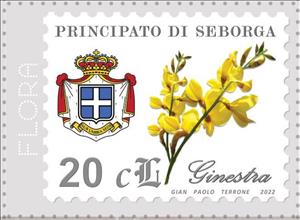Stamp: Broom (Cinderellas 2022)
Broom (Cinderellas 2022)
20 August (Cinderellas ) within release Italy : Principality of Seborga goes into circulation Stamp Broom face value 20 Seborgan cent
| Stamp Broom in catalogues | |
|---|---|
| Colnect codes: | Col: IT-SB 2022-03/8 |
Stamp is square format.
Stamp from mini sheetAlso in the issue Italy : Principality of Seborga:
- Stamp - Bee face value 20;
- Stamp - Black tomato face value 20;
- Stamp - Boar face value 20;
- Stamp - Broom face value 20;
- Stamp - Church of San Bernardo face value 20;
- Stamp - Church of San Martino face value 20;
- Stamp - Coat of arms of the Principality face value 20;
- Stamp - Flag of the Principality face value 20;
- Mini Sheet - Flora, fauna and food S/S face value 9*20;
- Stamp - Guards face value 20;
- Stamp - Knights Templar face value 20;
- Stamp - Knights Templar face value 20;
- Stamp - Luigino coin, 1669 face value 20;
- Stamp - Luigino coin, 2021 face value 20;
- Stamp - Mimosa face value 20;
- Stamp - Nina Menegatto (1978-), Princess of Seborga face value 20;
- Stamp - Nina Menegatto (1978-), Princess of Seborga face value 20;
- Stamp - Olive tree face value 20;
- Stamp - Pastel drawing of Piazza della Libertà face value 20;
- Stamp - Pastel drawing of Piazza della Libertà face value 20;
- Stamp - Pesto face value 20;
- Stamp - Taggiasco oil face value 20;
- Stamp - View of Seborga face value 20;
- Stamp - View of Seborga, Fiat 500 and Princess Nina face value 20;
- Mini Sheet - Views from the Principality of Seborga S/S face value 6*20;
- Mini Sheet - Views from the Principality of Seborga S/S face value 9*20;
- Stamp - Wild rabbit face value 20;
|
Data entry completed
50%
|
|
|---|---|
| Stamp Broom in digits | |
| Country: | Cinderellas |
| Date: | 2022-08-20 |
| Emission: | Cinderella |
| Format: | Stamp |
| Face Value: | 20 Seborgan cent |
Stamp Broom it reflects the thematic directions:
A coat of arms is an heraldic visual design on an escutcheon (i.e. shield), surcoat, or tabard. The coat of arms on an escutcheon forms the central element of the full heraldic achievement which in its whole consists of shield, supporters, crest, and motto. A coat of arms is traditionally unique to an individual person, family (except in the United Kingdom), state, organisation or corporation.
In British heraldry, a coronet is any crown whose bearer is less than sovereign or royal in rank, irrespective of the crown's appearance. In other languages, this distinction is not made, and usually the same word for crown is used irrespective of rank (German: Krone, Dutch: Kroon, Swedish: Krona, French: Couronne, etc.) In this use, the English coronet is a purely technical term for all heraldic images of crowns not used by a sovereign, and implies nothing about the actual shape of the crown depicted. A Coronet is another type of crown, but is reserved for the lower ranks of nobility like Marquesses and Marchionesses, Earls and Countesses, Barons and Baronesses, and some Lords and Ladies. The specific design and attributes of the crown or coronet signifies the hierarchy and ranking of its owner.
A flower, sometimes known as a bloom or blossom, is the reproductive structure found in plants that are floral (plants of the division Magnoliophyta, also called angiosperms). The biological function of a flower is to effect reproduction, usually by providing a mechanism for the union of sperm with eggs. Flowers may facilitate outcrossing (fusion of sperm and eggs from different individuals in a population) or allow selfing (fusion of sperm and egg from the same flower). Some flowers produce diaspores without fertilization (parthenocarpy). Flowers contain sporangia and are the site where gametophytes develop. Many flowers have evolved to be attractive to animals, so as to cause them to be vectors for the transfer of pollen. After fertilization, the ovary of the flower develops into fruit containing seeds. In addition to facilitating the reproduction of flowering plants, flowers have long been admired and used by humans to beautify their environment, and also as objects of romance, ritual, religion, medicine and as a source of food.
Flora is the plant life occurring in a particular region or time, generally the naturally occurring or indigenous—native plant life. The corresponding term for animal life is fauna. Flora, fauna and other forms of life such as fungi are collectively referred to as biota. Sometimes bacteria and fungi are also referred to as flora, as in the terms gut flora or skin flora.




